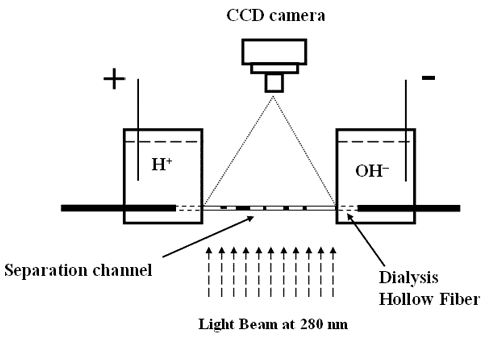Whole Column Imaging Detection (WCID)
WCID is a novel detection technology for capillary electrophoresis (CE) and capillary isoelectric focusing (CIEF). The principle of WCID can be illustrated with the UV absorbance version coupled with CIEF as shown in figure below. A short capillary (usually a few cm long) is used as the separation channel, which is connected with two pieces of capillary through two dialysis hollow fibre junctions. The dialysis hollow fibre junctions contact the electrolyte reservoirs and provide electric conduction and passage of small ions (such as protons and hydroxyl ions), but confine large molecule (such as protein and peptide) inside the capillary. Once a high voltage is applied to the cartridge, the analytes inside the separation channel will be focused to a certain pH to which the pI of the analyte equals. The focused analyte bands are imaged with a CCD camera. Compared to the conventional single point detection used for CIEF, WCID eliminates the mobilization process and thus has several advantages. At first, the coherent high resolution in CIEF can be maintained (proteins with pI difference as low as 0.03 pH unit can be resolved). Second, WCID provides a fast separation (usually less than 5 min). Third, over-focusing can be avoided by simply terminating the focusing process at the desired time.

WCID also can be applied to CE. In some CE separations, the analytes are resolved within a short distance of the column length, but they have to travel the entire distance of the column to be detected. When WCID is applied in such cases the separation time can be greatly reduced. WCID is also very suitable for multi-channel CE separation.
To date three detection modes have been used for WCID: 1) concentration gradient, 2) UV absorption, and 3) laser-induced fluorescence (LIF). This technology has been patented (US Patents 4784494, 4940333, and 4993832), and is being commercialized by Convergent Bioscience Ltd. (Toronto, ON).
Research Focuses
- Development of LIF-WCID technology for CIEF and CE
- Two dimensional (2-D) separations with CIEF as one dimension, including CE-CIEF and CE-MS
- In vitro studies of protein reactions and interactions
- Carrier ampholyte-free CIEF
- Miniaturization of CIEF-WCID
- SPME coupled with CE-WCID or CIEF-WCID
WCID Illustrations
On-line WCID slide illustration is available here to get a better picture of this research. The description below also helps users for a clear understanding of the principle and the application.
Slide 1: Universal refractive index gradient WCID system
Slide 2: UV absorption WCID system
Slide 3: Multi-capillary detection system
Slide 4: CIEF-WCID of haemoglobins
Slide 5: Focusing in a dual capillary system
Slide 6: Principle of isoelectric focusing in tapered capillary
Slide 7: UV absorption WCID system with cone shaped capillary
Slide 8: Images of two hemoglobin variant zones focused in the uncoated tapered capillary
Slide 9: Fluorescence imaging system (transverse illumination)
Slide 10: CIEF-WCID of hCG sample with two BioMarkers
Slide 11: UV Absorbance images of the mixture of peanut Ag and Ab at different ratios.
Slide 12: CIEF-LCW-LIF-WCID system (Axial illumination)
Slide 13: CIEF of green fluorescent protein with LCW-LIF-WCID
Slide 14: CIEF of two phycobiliproteins with LCW-LIF-WCID
Slide 15: CIEF-LCW-LIF-WCID as a tool to monitor carbamylation of green fluorescent protein at successive reaction times
Visit the Publications page for a full list of publications.